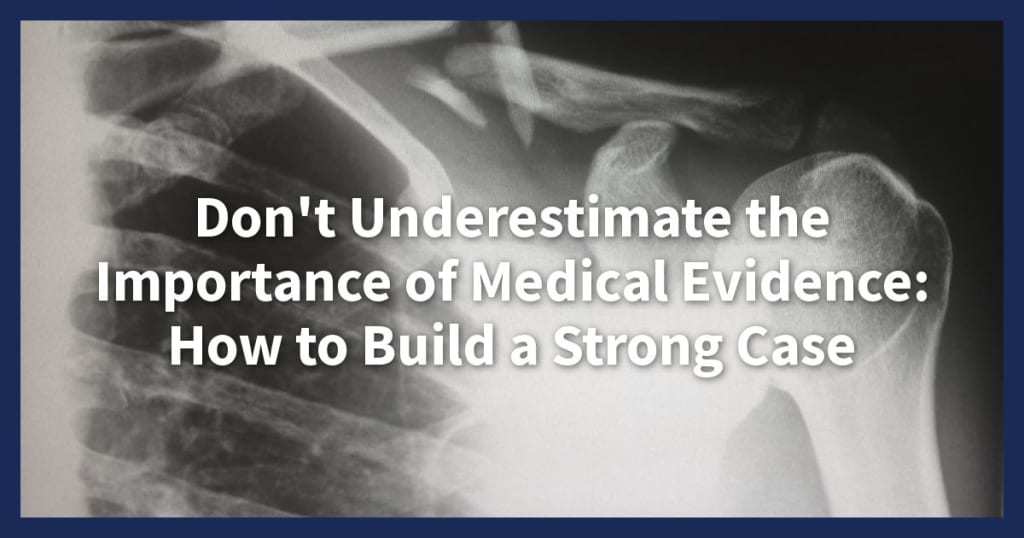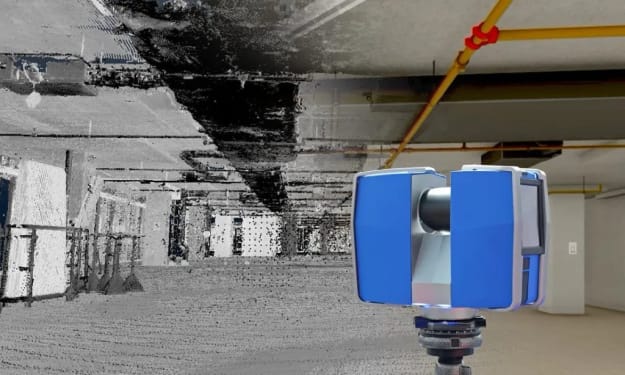Don't Underestimate the Importance of Medical Evidence: How to Build a Strong Case
Understanding the Role of Medical Evidence in Building a Strong Case

Don't Underestimate the Importance of Medical Evidence: How to Build a Strong Case
When it comes to building a strong case, medical evidence is one critical component you can't afford to overlook. This evidence can tip the scales in your favor, whether you're dealing with a personal injury lawsuit, a disability case, or any other health-related legal matter. It serves as the foundation of your case and can greatly increase your chances of success. Let's delve into why medical evidence is so important and how you can use it to build a robust case.
Understanding the Role of Medical Evidence in Building a Strong Case
Medical evidence plays a crucial role in legal proceedings, often serving as a cornerstone for building a strong case. In personal injury or medical malpractice lawsuits, it is essential to gather and present solid medical evidence to support your claims. This section will explore the importance of medical evidence in legal proceedings, how it supports your claims, and the common types of medical evidence used.
The Importance of Medical Evidence in Legal Proceedings
When it comes to legal proceedings, medical evidence holds significant weight in determining the outcome of a case. It provides objective and verifiable information that can substantiate your claims or refute the opposing party's arguments. The court relies on medical evidence to assess the extent of injuries, determine causation, establish negligence, and calculate damages.
Without strong medical evidence, your case may lack credibility and face challenges in proving the necessary elements to succeed. By presenting compelling medical evidence, you can strengthen your position, increase your chances of obtaining a favorable outcome, and potentially secure a fair settlement.
How Medical Evidence Supports Your Claims
Medical evidence serves as a vital tool to support your claims and establish a causal link between the incident and the damages suffered. It provides the court with a detailed understanding of your injuries, their severity, and the impact they have had on your overall well-being.
By presenting medical evidence, you can demonstrate:
Diagnosis and Treatment: Medical records, diagnostic tests, and treatment plans help establish the nature and extent of your injuries. These documents provide crucial information about the medical professionals involved, the timeline of treatment, and the recommended course of action.
Expert Opinions: Expert witnesses, such as medical specialists, can provide professional opinions based on their expertise and experience. Their testimonies lend credibility to your case and can help clarify complex medical concepts for the court.
Causation: Medical evidence helps establish a direct link between the incident and the injuries sustained. It can demonstrate that the negligence or wrongdoing of the opposing party directly led to your harm.
Prognosis and Future Damages: Medical evidence can assess the long-term effects of your injuries and estimate future medical expenses, loss of earning capacity, and other damages that may arise.
Common Types of Medical Evidence
In building a strong case, it is essential to gather various types of medical evidence that support your claims. Here are some common examples:
Medical Records: These include hospital records, doctor's notes, surgical reports, and any other official documentation related to your treatment. They provide a detailed account of your medical history, diagnoses, prescribed medications, and the treatments you have undergone.
Diagnostic Tests: X-rays, MRIs, CT scans, and other diagnostic tests can provide visual evidence of your injuries and help establish their severity.
Expert Witness Testimonies: Expert witnesses, such as medical professionals, can provide their specialized knowledge and opinions regarding your injuries, treatment, and long-term prognosis.
Photographic Evidence: Photographs of your injuries can provide a visual representation of the harm you have suffered. They can be particularly compelling in conveying the impact of the incident to the court and the jury.
Prescription Records: Documentation of prescribed medications and their dosages can demonstrate the extent of your pain and suffering, as well as the ongoing treatment required.
Witness Statements: Statements from witnesses who observed the incident or the effect of your injuries can support your claims. Their accounts can provide additional credibility and corroboration.
In conclusion, understanding the role of medical evidence is crucial when building a strong case. Medical evidence serves as a foundation, supporting your claims, establishing causation, and providing objective information to the court. By gathering various types of medical evidence, you can present a compelling case that increases your chances of achieving a favorable outcome in legal proceedings.
Gathering Relevant Medical Records and Documents
When building a strong case, one aspect that should never be underestimated is the importance of medical evidence. Medical records and documents play a crucial role in supporting your claim and proving the extent of your injuries or medical condition. In this section, we will explore the steps involved in gathering relevant medical records and documents, including requesting them from healthcare providers, organizing and reviewing them, and seeking expert opinions and medical reports.
Requesting Medical Records from Healthcare Providers
The first step in gathering medical evidence is to request your medical records from all relevant healthcare providers. This includes hospitals, clinics, doctors, specialists, and any other medical professionals who have treated or examined you. These records contain vital information about your medical history, diagnosis, treatment plans, medications, and any other relevant details.
To request your medical records, you will need to contact each healthcare provider individually and follow their specific procedures. This typically involves filling out a request form, providing identification, and, in some cases, paying a fee. It's important to ensure that you request records from all relevant providers to get a comprehensive view of your medical condition.
Organizing and Reviewing Medical Records
Once you have obtained your medical records, the next step is to organize and review them. Medical records can be extensive and complex, containing a wealth of information. To make sense of the records and identify the key details, it's crucial to organize them in a systematic manner.
One effective approach is to create a chronological order of your medical records, starting from the first consultation or visit and progressing through subsequent appointments or treatments. This allows you to easily track the progression of your medical condition and identify any inconsistencies or gaps in the documentation.
As you review your medical records, pay close attention to the following details:
Diagnosis: Identify the specific diagnoses provided by healthcare professionals and ensure they accurately reflect your medical condition.
Treatment: Review the treatment plans, medications prescribed, and any procedures or surgeries performed.
Progress: Look for notes or comments regarding the progression of your condition, improvement, or worsening of symptoms.
Test results: Take note of any laboratory test results, imaging scans, or other diagnostic tests that have been conducted.
By thoroughly reviewing your medical records, you can identify any areas that may require further investigation or clarification.
Seeking Expert Opinions and Medical Reports
In some cases, it may be necessary to seek expert opinions and medical reports to strengthen your case further. Expert opinions can provide additional credibility to your claim, especially when it comes to complex medical conditions or disputed diagnoses.
To obtain expert opinions, you can consult with independent medical professionals who specialize in the relevant field. These experts can review your medical records, conduct their own examinations if necessary, and provide their professional opinion regarding your condition, prognosis, and any potential long-term effects.
Medical reports prepared by these experts can serve as powerful evidence in your case, as they often carry significant weight in legal proceedings. These reports provide a detailed analysis of your medical condition, including expert testimony and recommendations for ongoing treatment or care.
In conclusion, gathering relevant medical records and documents is a crucial step in building a strong case. By requesting your medical records from healthcare providers, organizing and reviewing them meticulously, and seeking expert opinions and medical reports, you can ensure that you have a comprehensive and compelling body of evidence to support your claim. Remember, the strength of your case lies in the quality and relevance of the medical evidence you present.
Establishing a Causal Link between the Injury and the Incident
When it comes to building a strong case, one crucial element that should never be underestimated is establishing a causal link between the injury and the incident. This link serves as the foundation upon which the entire case rests, and it is essential in proving that the injury was a direct result of the incident in question. In this section, we will explore the importance of establishing causation, the role of medical evidence in proving causation, as well as the valuable contribution of expert witnesses in this process.
Importance of Establishing Causation
Establishing causation is vital because it demonstrates a clear connection between the incident and the subsequent injury. Without a solid causal link, it becomes challenging to prove that the injury was a direct result of the incident, leading to potential complications in the case. By clearly establishing causation, you strengthen your position and increase the likelihood of obtaining a favorable outcome.
Medical Evidence to Prove Causation
Medical evidence plays a pivotal role in establishing causation in a personal injury case. This evidence can include medical records, diagnostic tests, expert opinions, and other relevant documentation. By analyzing this evidence, medical professionals can determine the causal relationship between the incident and the resulting injury.
Medical records are a valuable source of information as they document the diagnosis, treatment, and progression of the injury. They provide tangible evidence that supports the claim and helps establish the link between the incident and the injury. Additionally, diagnostic tests such as X-rays, MRIs, or CT scans may reveal physical evidence of the injury, further strengthening the case.
Expert opinions from medical professionals who specialize in the specific field related to the injury are also crucial in proving causation. These expert witnesses possess the knowledge and experience to analyze the medical evidence and provide their professional opinion on the causal link between the incident and the injury. Their testimony can carry significant weight in court and can help persuade the judge or jury in favor of the injured party.
Expert Witnesses and Their Role in Establishing Causation
Expert witnesses play a crucial role in personal injury cases by providing specialized knowledge and insights. When it comes to establishing causation, these experts can provide their professional opinion based on their expertise in the relevant field. They can review medical records, examine diagnostic test results, and analyze other evidence to determine the causal link between the incident and the injury.
Their role extends beyond simply stating their opinion. Expert witnesses are responsible for presenting their findings in a clear and understandable manner, helping the judge and jury comprehend the complex medical aspects of the case. Their testimony can shed light on the causal relationship between the incident and the injury, contributing to the overall strength of the case.
In conclusion, establishing a causal link between the injury and the incident is of utmost importance when building a strong case in a personal injury claim. Medical evidence, including medical records and diagnostic tests, is indispensable in proving this causation. Additionally, the expert opinions of qualified witnesses can provide invaluable support by analyzing the evidence and offering their professional expertise. By solidifying the causal link, you increase the chances of achieving a favorable outcome in your case.
Presenting Medical Evidence Effectively in Court
Medical evidence is a crucial element in building a strong case and establishing the facts in a court of law. When presenting medical evidence, it is essential to do so effectively in order to maximize its impact and help the judge and jury understand the complexities of the medical issues involved. In this section, we will explore three key strategies for presenting medical evidence effectively in court: preparing clear and concise medical evidence summaries, using visual aids to enhance understanding, and the role of medical experts in testifying.
Preparing Clear and Concise Medical Evidence Summaries
One of the most important aspects of presenting medical evidence is ensuring that it is clear and concise. Complex medical terminology and lengthy reports can confuse and overwhelm both the judge and the jury, making it difficult for them to grasp the key points. To avoid this, it is crucial to prepare clear and concise medical evidence summaries that highlight the most relevant information.
A well-prepared summary should include an overview of the medical condition, the treatment received, and the impact of the injury or illness on the plaintiff's life. By condensing the information into a concise and easily understandable format, you can effectively communicate the essential details without overwhelming the court with unnecessary details.
Using Visual Aids to Enhance Understanding
Visual aids can be powerful tools in presenting medical evidence in court. They help to simplify complex medical concepts and make them more accessible to the judge and jury. Visual aids can include diagrams, charts, X-rays, and photographs that illustrate the medical condition, the extent of the injury, or the impact of the treatment.
By incorporating visual aids into your presentation, you can engage the court visually and enhance their understanding of the medical evidence. Visuals can help the court grasp the severity of an injury, the progression of a disease, or the effectiveness of a particular treatment. They provide a tangible representation of the medical evidence, making it easier for the court to connect with and remember the information presented.
The Role of Medical Experts in Testifying
When presenting medical evidence in court, the testimony of medical experts can be invaluable. Medical experts are professionals with specialized knowledge and experience in a particular medical field. Their testimony can provide the court with a deeper understanding of complex medical issues and help them make informed decisions.
Medical experts can explain the medical evidence in simple terms, answer questions from the court, and offer opinions based on their expertise. Their testimony adds credibility to the medical evidence presented and can significantly influence the judge and jury's perception of the case. It is essential to select qualified and reputable medical experts who can effectively communicate their knowledge and findings to the court.
In conclusion, presenting medical evidence effectively in court is crucial for building a strong case. By preparing clear and concise medical evidence summaries, using visual aids to enhance understanding, and leveraging the testimony of medical experts, you can maximize the impact of the medical evidence presented. Remember, the goal is to help the court understand the complexities of the medical issues involved and make informed decisions based on the evidence presented.
Overcoming Challenges and Objections to Medical Evidence
When building a strong case, it is crucial not to underestimate the importance of medical evidence. Medical evidence provides objective information that can support your claim and strengthen your position. However, there are often challenges and objections that arise when presenting medical evidence. In this section, we will explore how to address these challenges and overcome objections effectively.
Addressing Medical Evidence Contradictions
One common challenge in presenting medical evidence is when there are contradictions or inconsistencies within the medical records or expert opinions. It is essential to address these contradictions head-on to maintain the credibility of your case.
Firstly, carefully review and analyze all medical evidence to identify any conflicting information. Look for patterns or discrepancies that could be explained or challenged. It may be helpful to consult with medical experts or specialists who can provide insights into the contradictions.
Once you have identified the contradictions, develop a strategic approach to address them. This could involve obtaining additional medical opinions or conducting further investigations to gather supporting evidence. Presenting a comprehensive and cohesive narrative that explains and resolves these contradictions will strengthen the credibility of your case.
Dealing with Independent Medical Examinations (IMEs)
Another challenge that arises in many cases is the involvement of Independent Medical Examinations (IMEs). IMEs are evaluations carried out by medical professionals chosen by the opposing party or insurance company. Their purpose is to assess the claimant's condition and provide an independent opinion.
When facing an IME, it is crucial to be well-prepared. Gather all relevant medical records and documentation to present a comprehensive overview of the claimant's condition. Be transparent and honest with the IME doctor during the examination, ensuring they have a complete understanding of the case.
It is also essential to have your own medical expert review the IME report to identify any inaccuracies or biased opinions. If inconsistencies are found, challenge them by presenting counter-evidence and alternative expert opinions.
By being proactive and thorough in preparing for IMEs, you can mitigate the potential impact of these examinations on your case.
Handling Challenges from the Opposing Party
Opposing parties often challenge the validity or relevance of medical evidence presented. To effectively handle these challenges, it is crucial to have a solid understanding of the medical evidence supporting your case.
Stay up-to-date with the latest medical research and literature relevant to your case. This knowledge will allow you to confidently defend your position and address any objections raised by the opposing party.
Additionally, work closely with your medical experts to develop clear and concise explanations of the medical evidence. Ensure that your experts are readily available to answer any questions or provide further clarification when needed.
When faced with challenges from the opposing party, remain calm and composed. Use logical reasoning and clear communication to dismantle objections and reinforce the strength of your case.
Conclusion
Overcoming challenges and objections to medical evidence is a critical aspect of building a strong case. By addressing medical evidence contradictions, effectively dealing with IMEs, and handling challenges from the opposing party, you can strengthen your position and increase the chances of a favorable outcome. Remember to always be well-prepared, consult with experts, and stay knowledgeable about the latest medical research to make a persuasive argument in support of your case.
Conclusion
In conclusion, it is crucial not to underestimate the importance of medical evidence when building a strong case. Medical evidence provides the necessary support and credibility to your claims, making it easier for you to prove negligence or wrongdoing. By obtaining thorough medical documentation, including medical records, diagnostic tests, and expert opinions, you can strengthen your case and increase your chances of receiving fair compensation. Furthermore, medical evidence also helps establish the extent of your injuries and their impact on your life, ensuring that you are adequately compensated for your pain and suffering. So, when pursuing a personal injury or medical malpractice case, remember to prioritize gathering and presenting persuasive medical evidence to build a strong and compelling argument.
About the Creator
Jason Baril
Hello, everyone! My name is Jason Baril, and I'm excited to share my story with you all. attorney, I have a few passions that keep me busy - law, pickleball, technology, and writing.






Comments
There are no comments for this story
Be the first to respond and start the conversation.